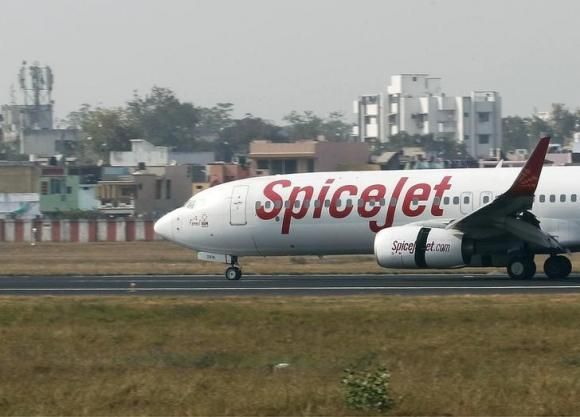While the airline is generating enough cash to maintain operations at current levels, its future will depend on cash infusion and the operational changes that follow.
 SpiceJet made headlines through all of 2014, mostly because of the frequent flash sales it launched to attract customers.
SpiceJet made headlines through all of 2014, mostly because of the frequent flash sales it launched to attract customers.
Concern was raised on the deteriorating financial health of the airline from various quarters intermittently: the Airports Authority of India (AAI) threatened to withdraw credit facility to the carrier a number of times, auditors termed the airline a “going concern” at quarterly results and employees sent frantic mails in June when SpiceJet failed to turn in the TDS certificate/Form 16 in time.
The Directorate General of Civil Aviation undertook a financial audit of the airline in August.
But it was only when reports of delays in salary payments started coming out earlier this month that a slew of measures was put in place to safeguard stakeholders (read passengers, vendors, airport operators, lessors) in the event the airline went bust.
What kept the authorities from intervening earlier? SpiceJet had been promising a possible recapitalisation of the airline for some time now.
The civil aviation ministry additionally was concerned about the loss of employment (sources quote 20,000 direct and indirect jobs) that the closure of the airline would entail.
But others weren’t ready to be as accommodating as the government. On December 15, oil companies refused to provide fuel on credit to SpiceJet.
Operations were severely disrupted in the next couple of days.
It is at this time that Ajay Singh, former promoter and director of SpiceJet, stepped in.
Some cash was arranged for the airline to restart operations. SpiceJet has now started operations on 230 sectors, against 345 in July, and has pressed into service 18 Boeing 737s (compared to 37 last year).
Sources in the civil aviation ministry say the airline has paid up to Rs 13 crore or Rs 130 million of dues to oil companies (only Rs 1 crore is pending). Now, it is buying fuel on a cash-and-carry mode, they add.
SpiceJet, ministry officials say, has opted for cash-and-carry because oil companies offer a discount of 13-16 per cent through this route. Now, however, it is willing to pay more, provided oil companies offer 30-day credit, as is the case with other airlines.
The airline has also assured AAI that it will give a bank guarantee of Rs 120 crore (Rs 1.20 billion) soon.
SpiceJet has dues of Rs 200 crore (Rs 2 billion) (as of December 5) with AAI.
Earlier, it had given a bank guarantee of Rs 82.5 crore, according to sources in the company.
Tying-up funds
SpiceJet has mobilised up to Rs 200 crore (Rs 2 billion) from investors. “Since the restriction on not accepting bookings beyond 30 days was eased, the airline has started generating Rs 9-10 crore a day.
Expenses stand at around Rs 5 crore.
The resources are sufficient to maintain operations at current levels,” says a person in the know. Company sources say SpiceJet is in talks with two US-based private equity funds for possible investments and a deal in this regard is likely to be sealed in the next six weeks.
Earlier, funds such as Goldman Sachs and Indigo Partners had evinced interest in the Indian aviation market. Senior executives from JPMorgan are understood to have met civil aviation ministry officials regarding a possible investment in the Kalanithi Maran-promoted airline.
Ministry sources add that Singh has submitted a plan to the government which might involve a consortium of foreign investors. All told, the plan is to pump in about Rs 1,200 crore, which experts believe will get the airline back on track.
SpiceJet has an exposure of about Rs 100 crore to City Union Bank, secured through collateral. It has also tax dues of Rs 100 crore.
The monetary infusion by investors could be accompanied by serious operational changes.
The two mistakes
Industry watchers point out two broad mistakes in SpiceJet’s strategy.
The first was former CEO Neil Mills’ decision to change the airline’s business model.
SpiceJet decided to seek the first mover advantage on uncharted sectors like Hubli, Tirupati and Amritsar.
As a result, it was forced to change its fleet from a single type of aircraft, the Boeing 737, to include 78-seat Bombardiers.
Most budget carriers stick to one aircraft family in order to keep the expenditure on maintenance and spares on a tight leash.
SpiceJet, however, did not assess if these sectors could generate sufficient business.
The second mistake was its aggressive turnaround strategy based on discounted fares in the hope that the loss would be more than made up by the increase in passenger load. This did not happen.
Airlines typically have two ways to drum up business.
They can keep fares stable even if it means low passenger loads.
That is what IndiGo does.
The alternative SpiceJet chose was to drop fares and improve revenue through higher passenger loads.
There is nothing wrong in this as long as the cost of the flight is covered.
If it is not, the downside of this strategy is severe.
“Higher passenger load means you have to load more fuel, the staff will be under pressure because the airline has to handle more passengers, the chance of delay will be enhanced and if you are on cash-and-carry for oil, you have to fork out more,” says a senior executive with an airline.
It still works if an airline makes the revenue on a flight to match costs. Though SpiceJet’s revenue per available













 © 2025
© 2025